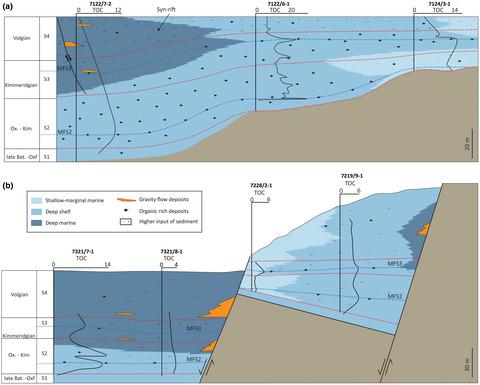当前位置:
X-MOL 学术
›
Basin Res.
›
论文详情
Our official English website, www.x-mol.net, welcomes your
feedback! (Note: you will need to create a separate account there.)
The Middle Jurassic to lowermost Cretaceous in the SW Barents Sea: Interplay between tectonics, coarse‐grained sediment supply and organic matter preservation
Basin Research ( IF 2.8 ) Pub Date : 2020-08-25 , DOI: 10.1111/bre.12504 Dora Marín 1 , Solveig Helleren 1 , Alejandro Escalona 1 , Snorre Olaussen 2 , Andrés Cedeño 1 , Henrik Nøhr‐Hansen 3 , Sverre Ohm 1
Basin Research ( IF 2.8 ) Pub Date : 2020-08-25 , DOI: 10.1111/bre.12504 Dora Marín 1 , Solveig Helleren 1 , Alejandro Escalona 1 , Snorre Olaussen 2 , Andrés Cedeño 1 , Henrik Nøhr‐Hansen 3 , Sverre Ohm 1
Affiliation

|
Syn‐rift successions contain both prolific organic‐rich and coarse‐grained rocks, but these rocks are usually studied independently. Thus, the interplay among organic matter deposition, tectonics and sediment supply is not commonly assessed. In this study, we use well logs, Total Organic Carbon (TOC) content, biostratigraphy and seismic data from the SW Barents Sea to unravel the variability of organic‐rich successions and its interaction with potential reservoir rocks in areas affected by active normal faulting versus tectonically stable areas. Four Transgressive‐Regressive (T‐R) sequences were defined for the Middle to Upper Jurassic Fuglen Formation and for the organic‐rich Upper Jurassic to lowermost Cretaceous Hekkingen Formation. Three TOC trends, controlled by palaeobathymetric variations, and organic matter dilution, were identified within the two main organic‐rich sequences (sequences 2 and 3): (a) wells with the highest TOC values (>10 wt %) at the base of the succession; (b) wells with the highest TOC values at the top of the succession and (c) wells with high TOC values at the base and top of the succession. Our interpretation indicates that fault activity controlled the TOC trends in two different ways: Firstly, by creating a sharp topographic contrast‐triggering hyperpycnal flows, and shallowing the footwalls, where higher oxygen content and less developed stratified waters lowered organic matter preservation. Secondly, by significantly increasing the input of clastic material, which inherently led to dilution of organic matter and resulted in lower TOC values (<6 wt %). We interpret that sand deposition was controlled by the size and geomorphology of the sediment source areas. The western part of the study area (i.e. the Loppa High) was characterized by uplifted footwall islands and localized sands along their flanks, whereas the southern part (i.e. the Finnmark Platform) constituted a larger sediment source area for the Volgian age. This work has implications for a better understanding of the distribution of reservoir and source rocks in active rift basins.
中文翻译:

巴伦支海中侏罗纪至白垩纪最下层:构造,粗粒沉积物供应与有机质保存之间的相互作用
同理裂隙演替既包含多产的富含有机物的岩石,也包含粗粒的岩石,但是这些岩石通常是独立研究的。因此,通常不评估有机物沉积,构造和沉积物供应之间的相互作用。在这项研究中,我们使用了来自巴伦支海的测井记录,总有机碳(TOC)含量,生物地层学和地震数据,以揭示受活动正断层影响的地区富含有机物演替的变化及其与潜在储层岩石的相互作用。构造稳定的区域。为中侏罗统Fuglen组和有机质丰富的上侏罗纪至最下部的白垩纪赫金根组定义了4个海侵-渐进(T-R)序列。受古生物计量学变化和有机物稀释控制的三种TOC趋势,在两个主要的富含有机物的序列(序列2和3)中被识别出来:(a)在演替基部具有最高TOC值(> 10 wt%)的孔;(b)TOC值最高的井位于演替序列的顶部,(c)TOC值较高的井位于演替序列的底部和顶部。我们的解释表明,断层活动以两种不同的方式控制了TOC趋势:首先,通过形成尖锐的地形反差触发高能流,并使底壁变浅,其中较高的氧含量和较不发达的分层水降低了有机物的保存能力。其次,通过显着增加碎屑材料的输入,这自然导致有机物的稀释并导致较低的TOC值(<6 wt%)。我们解释说,沙的沉积受沉积物来源地区的大小和地貌控制。研究区的西部(即Loppa高地)的特征是抬高的底盘岛和沿其侧面的局部沙土,而南部(即Finnmark平台)则构成了伏尔加时代较大的沉积物来源地区。这项工作对于更好地了解活跃裂谷盆地储层和烃源岩的分布具有重要意义。
更新日期:2020-08-25
中文翻译:

巴伦支海中侏罗纪至白垩纪最下层:构造,粗粒沉积物供应与有机质保存之间的相互作用
同理裂隙演替既包含多产的富含有机物的岩石,也包含粗粒的岩石,但是这些岩石通常是独立研究的。因此,通常不评估有机物沉积,构造和沉积物供应之间的相互作用。在这项研究中,我们使用了来自巴伦支海的测井记录,总有机碳(TOC)含量,生物地层学和地震数据,以揭示受活动正断层影响的地区富含有机物演替的变化及其与潜在储层岩石的相互作用。构造稳定的区域。为中侏罗统Fuglen组和有机质丰富的上侏罗纪至最下部的白垩纪赫金根组定义了4个海侵-渐进(T-R)序列。受古生物计量学变化和有机物稀释控制的三种TOC趋势,在两个主要的富含有机物的序列(序列2和3)中被识别出来:(a)在演替基部具有最高TOC值(> 10 wt%)的孔;(b)TOC值最高的井位于演替序列的顶部,(c)TOC值较高的井位于演替序列的底部和顶部。我们的解释表明,断层活动以两种不同的方式控制了TOC趋势:首先,通过形成尖锐的地形反差触发高能流,并使底壁变浅,其中较高的氧含量和较不发达的分层水降低了有机物的保存能力。其次,通过显着增加碎屑材料的输入,这自然导致有机物的稀释并导致较低的TOC值(<6 wt%)。我们解释说,沙的沉积受沉积物来源地区的大小和地貌控制。研究区的西部(即Loppa高地)的特征是抬高的底盘岛和沿其侧面的局部沙土,而南部(即Finnmark平台)则构成了伏尔加时代较大的沉积物来源地区。这项工作对于更好地了解活跃裂谷盆地储层和烃源岩的分布具有重要意义。











































 京公网安备 11010802027423号
京公网安备 11010802027423号